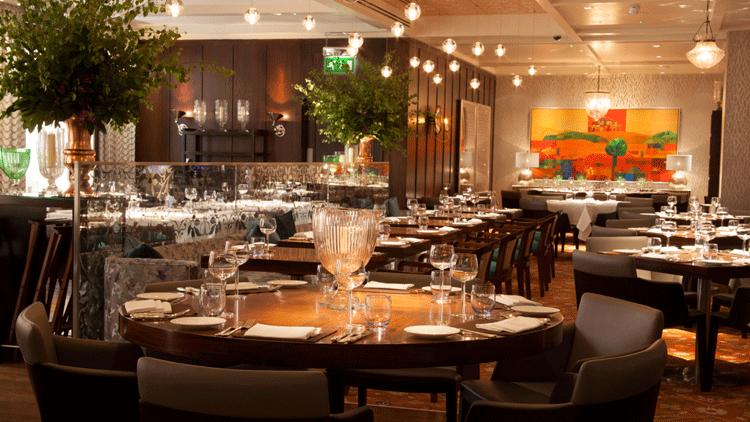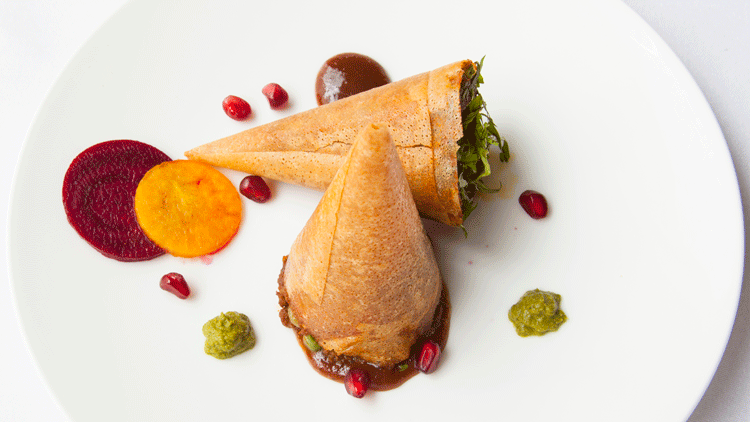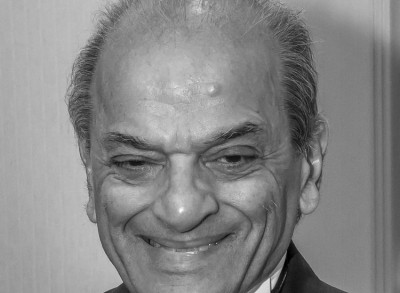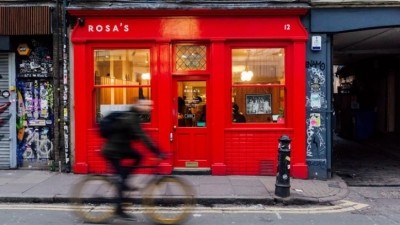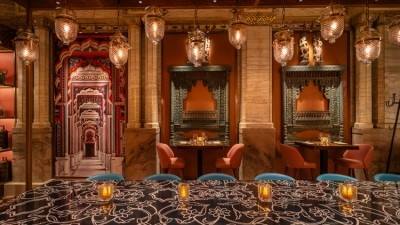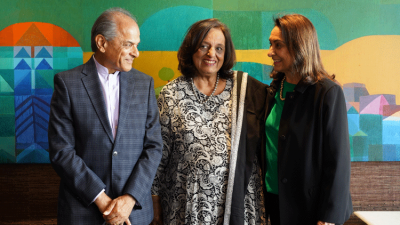Chutney Mary at 30: how one restaurant changed London's Indian dining scene
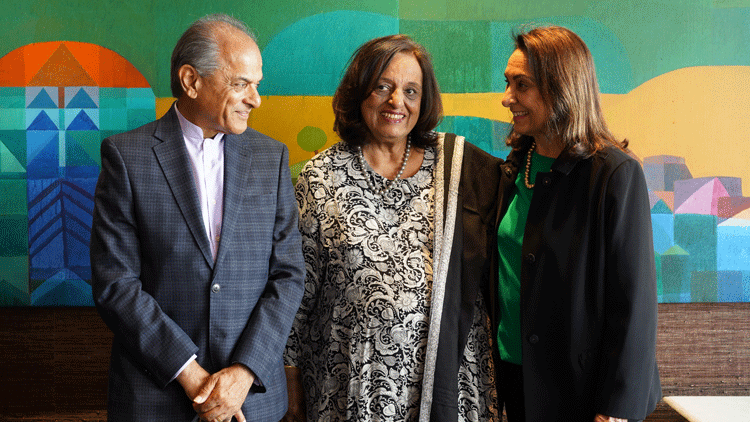
"I've brought a few things with me..." Camellia Panjabi hands me three neatly-labelled poly pockets filled with old menus, press releases and largely glowing reviews that chart the evolution of London's most influential and - probably - most admired Indian restaurant.
Usually based in India, the bestselling cookery writer is seeing out the Coronavirus crisis at the central London home of fellow co-owners Namita Panjabi, her sister, and Ranjit Mathrani, her brother-in-law.
We’re sitting in Chutney Mary’s opulent Pukka Bar knocking back champagne, and why not? A restaurant reaching 30 years of age is a rare thing indeed and Chutney Mary has achieved far more than most.
It was the first restaurant in London, and quite possibly the world, to make the argument that - just like Western cuisine - Indian food could be elevated and served in a manner that was both upmarket and creative.
To this end, Chutney Mary put its money where its mouth was, launching with prices that were comparable to top-end European restaurants despite Indian food being nearly universally thought of as cheap and cheerful curry house grub. Sadly, this notion still persists in some circles, but it would be more pervasive if it weren’t for the trio’s efforts.
Indeed, the success of Chutney Mary paved the way for the creation of what is arguably the UK’s most successful Indian restaurant business. The trio launched two further Indian fine dining restaurants - grill restaurant Amaya in Knightsbridge and the more traditional Veeraswamy near Piccadilly Circus - alongside the seven-strong Masala Zone, which started out as a casual dining chain but has in recent years transitioned to more of a mid-market proposition.
Even more importantly, Chutney Mary and the wider MW Eat business has inspired countless other forward-thinking Indian restaurants, from Benares, The Cinnamon Club and Gymkhana right through to Dishoom and Mowgli.
Modern Indian chic: Chutney Mary's current dining room
There's something about Mary
Each of the three collections of documents corresponds to three distinct eras of the restaurant: its launch in 1990 as a high-end Anglo-Indian with some regional dishes, a 2001 revamp that saw it take a more overtly regional approach to its menus and Chutney Mary as it is today following a move from its original home in Chelsea to the West End in 2015.
The septuagenarian trio are sharp as tacks and occasionally spar with each other as they discuss the history of the business. Each have well-defined roles at Chutney Mary that are mirrored in the wider MW Eat empire. As chairman the delightfully mischievous Mathrani handles finance and logistics while Camellia and Namita are the creative minds behind the business. Both are closely involved in the menus and the corralling of the chefs with the latter also responsible for the look and feel of the restaurants.
Midnight's children
Chutney Mary’s success is down to hard work, consistency of ownership and Mathrani’s impressive business acumen but perhaps most importantly the Punjabi sister’s encyclopaedic knowledge of Indian food.
This is down to down to their privileged upbringing in Indian in the 50s and 60s – Namita says they are midnight’s children, a reference to Salman Rushdie famed book about India’s transition from British colonialism to independence.
As card-carrying members of the Indian elite, the pair travelled the subcontinent with their parents visiting maharajas in their palaces and experiencing regional specialities at their best.
"There are very few people that I know whose palates can span a whole continent," explains Mathrani, who was also born into an extremely well-to-do Indian family. "They can go from a Bengali dish to a Keralan dish to a Goan dish and pinpoint its very essence. They understand exactly how it needs to be."
"We were interested,” says Namita. “We talked to chefs who were incredibly knowledgeable about the food of their region. We grew up being able to explain the difference between Jaipur lamb and Jabalpur lamb."
All three studied at Cambridge, Mathrani meeting his future wife through Camellia (Namita was a few years behind them). After university, Camellia put her culinary knowledge to use straight away, taking a job at Taj Hotels. She moved quickly through the ranks to become marketing director.
She had far more influence over the culinary direction of each property than that title suggests, working with chefs to create new restaurants as the Taj Group converted some of the palaces she ate in as a child to upscale hotels.
"We'd research local dishes. It’s important to bear in mind that there were very few restaurants and hotels in India at that point," says Camellia. "We were talking to former palace chefs and going into people's homes."
Her sister and brother-in-law had similarly high-flying careers. Namita worked as a fashion buyer for major department stores including Harrods and Saks Fifth Avenue. The role saw her travel the length and breadth of India, allowing her to further her knowledge of regional Indian cuisine.
Ranjit joined the civil service in 1967 but left as a high-powered mandarin in 1984 to pursue an equally successful career as a merchant banker holding senior roles at major banks before starting his own international financial advisory business, Vanguard Capital, in 1993, advising governments and major corporations.
The early days of the business
Opinions on the precise genesis of Chutney Mary vary. Camellia asserts that the restaurant is the result of a conversation between Mathrani and friend Neville Abraham on the former's wedding day. The feast served was so good it was entirely self-evident that all those involved should immediately enter the restaurant business together.
Camellia was already part of the London scene having opened Bombay Brasserie in Kensington for Taj Group, itself a landmark Indian restaurant opening.
"Prior to Bombay Brasserie Indian restaurants did not exist, only curry houses,” she recalls. “The only middle-end restaurant was Gaylord in Mayfair. There were also a couple of good Pakistani restaurants in Knightsbridge.”
Mathrani believes his sister-in-law’s version of events is an oversimplification, and that he and Abraham - who would go on to found highly successful national French restaurant chain Chez Gérard - had discussed the possibility of going into the restaurant business long before his and Namita’s nuptials.
“Neville and I had worked together in the civil service,” he explains. “After that I became an investment banker, a job that required me to monetise talent. I saw the success of Bombay Brasserie and how complementary Camellia and Namita’s skill sets would be. It was clear to me we should create something that harnessed all that talent and experience.”
Mathrani says that the involvement of Abraham and Chutney Mary’s other original backer Laurence Isaacson was entirely serendipitous. The family bumped into the pair during a pitch meeting to the landlord of a site in Kensington Church Street and decided to go into business together.
Mathrani and Abraham raised the cash (anyone that’s talked to a bank about funding a restaurant in the last twenty years will be amazed to learn that NatWest provided 70% of the capital value of the project) and found a large site on the Fulham end of Kings Road.
Camellia was still working at Taj Group at the time (she left in 2001) and was therefore not officially involved in the business when Chutney Mary launched, although she did have some input.
The restaurant’s name refers to Indian women that adopted Western ways during the time of the Raj: “a chutney trying to be a Mary”, as Camellia puts it (she includes her sister and herself as being in this bracket).
Two different worlds
“You could say that our upbringing was Anglo Indian,” explains Namita. “Our schoolteachers were Scottish. We thought we were eating British food at school lunch, but it turned out they were Anglo Indian dishes. The first iteration of Chutney Mary was largely based on the food of our childhood. We wanted to preserve it, it felt like it was fading away.”
Anglo Indian dishes on the original menu included ‘country captain’ a mild dish prepared for British Army captains of chicken braised with chillies, almonds, raisins and spices served with lemon rice; pan-fried lamb chops coated with mash potato served with mint chutney and wilted greens; and salmon and chutney khitchri, a forerunner of kedgeree.
Alongside these were ‘unabashedly Indian’ dishes ‘presented unconventionally by Chutney Mary’. These included a mixture of then familiar dishes such as roghan josh and less obvious dishes such as lamb narangi, a dish of boneless lamb served in orange-flavoured curry sauce.
The food was both original and well-executed. “At the time it was unheard of for Indian restaurants not to use freezers,” says Camellia. “We banned them in our kitchen. The chefs would come in every day and start from scratch. This made a huge difference to the quality. We also used a much better class of produce than any other Indian restaurant.”
But the thing that really set the Chutney Mary kitchen apart from other Indian restaurants was its recruitment policy and the way the kitchen was structured. Camellia and Namita went to great lengths to secure chefs with exactly the right regional cooking experience to cook the dishes on their section.
"God is in the detail. When I look at hiring a chef I go right back to his grandfather,” says Camellia. “I want to know what village they came from and where they worked in their first job, second job, third job, fourth job…”
“And we tested and tested,” adds Namita. “We asked them to cook the regional specialities for us.”
At the time, the best food in India was found in people’s homes, in palaces and on the street. Restaurants are a comparatively recent idea on the sub continent so most of the chefs the pair were getting over from India were ‘raw’ with limited or no experience of a la carte cooking.
While neither of the Panjabi sisters have ever cooked in a professional kitchen, both understand precisely how specific dishes should taste. On top of that, Camellia has a detailed understanding of Indian technique: her debut cookbook 50 Great Curries of India has sold in excess of one million copies.
They also understood the refinements that needed to be made to regional Indian dishes in order for them to be served at a restaurant like Chutney Mary.
“Chefs need direction,” explains Camellia. “You can’t cook the same food you’d cook at a Bengali family home in a London restaurant. The presentation needs to change, the amount of oil needs to be reduced and you can’t cook the meat right through.”
Chutney Mary’s original look was based on the India of the 1920s and 1930s. There were murals depicting the British in India and even the titular Chutney Mary herself dining with British officers. Staff were garbed in uniforms that continued the colonial theme.
“There was a lot of Western influence front of house,” says Namita. “But back of house was completely Indian. It was two different worlds.”
Chutney Mary’s second phase
Over time, the more ‘authentic’ and less Anglicised dishes became the bestsellers, triggering a rethink of the restaurant’s overarching concept. Namita recalls the popularity of limited-time menus that celebrated the food of a particular region.
“It became clear that our customers wanted us to dig deeper into these cuisines,” she says. “The British palate had become more sophisticated and the colonial theme and look had had its day. We turned Chutney Mary into a more modern restaurant. The style changed dramatically and - I believe - set the benchmark for all Indian restaurants that came after it.”
“You have to remember that at that time there was no Indian restaurant in the world that was seeking to be contemporary,” adds Mathrani. “The 2001 changes coincided with Camellia officially joining the business. We made the experience far more sophisticated.”
Namita takes the example of Chutney Mary’s take on Kerala roast duck, which is still on the menu to this day. Traditionally, a whole duck is roasted, broken down and then cooked again in a complex, heavily-spiced sauce. Chutney Mary’s chefs cooked the duck breasts pink and served them with a more intense version of the sauce made using the rest of the bird. That might not sound revolutionary now, but at the time it was.
During this period Chutney Mary chalked up many firsts. It was the first Indian restaurant in London to serve foie gras and game and fresh seafood and the first to have a serious wine list. The food became even more refined and the prices went up commensurately.
“We've always been thought of as expensive for Indian food,” says Namita. "There was a perception that Indian food could never justify a high price point because it was ‘just curry’. We buy the same produce as good western restaurants. In fact, back then we used the same butcher as Gordon Ramsay did at Aubergine. We pay our staff the same and we have restaurants in the same locations. Why shouldn’t we charge more?”
As the years wore on the London restaurant market started to change rapidly. Significant investment in the sector saw the number of ambitious restaurants increase exponentially and – encouraged by the success of Chutney Mary – a number of high-reaching Indian opened their doors, including Rasoi, Tamarind, Benares and The Cinnamon Club.
The centre of gravity had also shifted eastwards, with the majority of Chutney Mary’s competitors choosing to base themselves within or at least near to the West End.
“Chelsea wasn't the restaurant hotspot it once was,” says Mathrani. “We did of course have a loyal customer base there, but we suffered from being that little bit further out. Our City-based customers in particular were settling for the West End rather than coming over to Chelsea.”
With the 20-year lease close to coming to an end, the trio started looking for a new home for Chutney Mary, eventually settling on 73 St James's Street. It had most recently been operated by Marco Pierre White but is best known for being the former site of French fish restaurant Prunier St James’s, which traded from 1934 to 1976.
“We were just about to give up on finding a site when it came up,” Mathrani continues. “In pure location terms it’s not great because you have parks to the south and to the west. But the space was the most important thing – we needed something that was large and grand - and we felt that Chutney Mary had enough of a pull factor to get people there.”
“The site had previously been difficult to fill, in fact it was something of a graveyard for restaurants. But we’re delighted with the move, it fits Chutney Mary perfectly.”
Light touch: Chutney Mary's venison-based take on the samosa
The star that never came
The 2015 move reinvigorated interest in a restaurant that had perhaps dropped off people’s radars. Chutney Mary chalked up a string of glowing reviews from critics including Grace Dent, Fay Maschler and the late AA Gill, who was an especially big fan of the restaurant.
It’s not difficult to see what the critics see in the place. There’s a pleasingly old school feel to both the service and the food, but the cooking is as vibrant as ever. In fact, it’s incredible to think that many of the dishes have been on the menu for three decades, including the tokri chaat - fired potato baskets packed filled with vegetables and topped with various spices and chutneys - and an extraordinary Goan green chicken curry that’s packed with aromatic herbs and spiked with tamarind.
The trio regard Chutney Mary as the jewel in their empire’s crown and are therefore quietly baffled that Michelin has yet to give it a star, especially as both Amaya and Veeraswamy won Michelin stars shortly after opening and have retained them ever since.
This one niggle aside, they appear content with what the restaurant has achieved and how it is perceived by customers and - as importantly, it appears - their peers.
“We have raised the ambitions of other Indian chefs and restaurateurs,” says Mathrani. “Some have imitated us; others have created restaurants that contrast with our own. But all of them have spent a lot of time at our places, and Chutney Mary especially. That's fine. We take it as a compliment.”
30 years is a milestone that vanishingly few restaurants mange to hit. The trio put Chutney Mary’s longevity down to its willingness to evolve. “The emphasis on great food never changes,” says Camellia. “But great food is not stationary. What is great today can be dated tomorrow. We’re continually reinventing.”
As Mathrani says, here’s to another 30 years.
